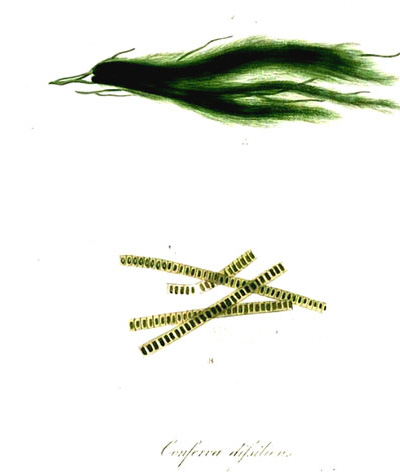| 3 - Candolle's Diatoma | |
|
Candolle's Diatoma included only two species, ones he had collected from the northern marine coast of France -- in Calvados, probably near Gold Beach, and near Dieppe in Seine-Maritime -- where they grew epiphytically on seaweeds, especially on Ceramium and various species of Fucus. He examined them microscopically and judged that each had been previously described in 1797 as species of Conferva in a German local inland flora of new and poorly known plants, Albrecht Roth's Botanical Gatherings [= Catalecta Botanica]. Thus, while Diatoma was new, its species were not. Candolle just shifted their position from resident in an increasingly corpulent Conferva into a virgin Diatoma. |
|
|
He characterized his new Diatoma as Figure 6. Flore française, ed. 3, vol. 2, p. 48 (1805). |
 |
|
CHARACTERS. The filaments of diatoms are simple, composed of segments which, at the end of life of the plant, divide themselves transversely one from the others, except by one of their.corners; and thus form a series of rhomboidal, transversely striated segments. [All translations are the author's unless indicated otherwise.] |
|
 |
The focus of Candolle's description was the unbranched
(simples) filament (filamens), not the items that compose
it. What we would now interpret as individual cells (his articles)
were simply components (segments) of the filament separated by joints
or nodes; the filament was the plant, not its segments. Conferva
has a long botanical history, originating in the works of Pliny the
Elder in the first century A.D. and continuing into those of Linnaeus
and Roth as a genus of algae, of aquatic plants without leaf or root.
Candolle's description of diatoms as unbranched transversely segmented
algal filaments does not differentiate them from Conferva (Figure
7) [Note
3]. His further description indicated the plants transversely
separated at their joints (or nodes) except at one of their corners.
It would appear that this character -- in contemporary terminology,
the partial separation of sibling valves or frustules forming a more-or-less
zig-zag colony of cells -- was his basis for excising these species
from Conferva. His focus was the periodic clefts in the filament.
We are forced to largely imagine in our mind's eye what Candolle saw,
because he did not illustrate any species of Diatoma. And specimens
of its species collected by him do not reside in his collections in
Geneva from which we might re-examine them. If we could, they probably
would reveal Candolle was not looking at what we would call today a
Diatoma, a freshwater genus, but rather any of several marine
genera -- Rhabdonema, Striatella, Grammatophora and others --
which form similarly shaped colonies (see Figure 10). Figure 7. Conferva dissiliens from Lewis Dillwyn's British Confervae (1809). Mouseover the image for an illustration of the terminology of Candolle's day applied to Conferva. |
But, he did provide direct reference under one of the species, Diatoma flocculosum, to Roth's illustration of this species (Figure 8), and it agrees tolerably well with his description of the genus. His name determinations for his "Diatoma" specimens may have been incorrect from a present-day perspective, but for our purposes his diagnostic focus on the form is clear and the more important point with respect to the name. |
|
 |
|
|
Figure
8. Conferva
flocculosa from Roth's Catalecta Botanica, vol. 2, fig. 6,
(1797). This figure was cited by Candolle as representing
his concept of Diatoma flocculosum. Image: Botany Libraries, Harvard University. |
|
| <-- 2 - Flore Française - |

Creative Commons Attribution-NonCommercial-NoDerivs 3.0 Unported License